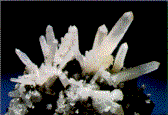 |
Samson Jewellery
Gem Criteria |
|
Gems have certain attributes that
help to establish their value. These are subjective and may change with time and
fashion.
[Hardness|Rarity|Color|Brilliance and dispersion|Clarity|Transparency|Beauty|Portability]
¡@ |
| Hardness |
It is very important, because a gem that
scratches too easily will quickly become dull. Nonetheless, some extremely soft
minerals are cut as collector gemstones. The term "durability" is more
useful in gauging the wearing characteristics of a gem, because some materials, such as
jade, may not be very hard but are "tough" and are not easily chipped or broken. |
| Rarity |
It is major factor in determining a gem's
value. There are different kinds of rarity, including exceptional size, an unusual
degree of clarity, or an especially fine color. A particular species or color
variety may be rare and highly prized but later fall in value if large deposits of it are
discovered. |
| Color |
It is of paramount importance for almost
all gems. It can make the difference in some gem stones. The range of
coloration in minerals is enormous, and great subtleties exist even within a single
species. |
Brilliance
and
Dispersion |
They affect gem value, especially in the
case of colorless materials. Brilliance is the effect produced by the reflection of
light from the gem to the eye, is largely a function of proper cutting. Dispersion
is the optical phenomenon that creates the color play in diamond. High dispersion is
found in only a few stones, but in these it is responsible for an unusual degree of
beauty. Usually brilliance is sacrificed to some degree when a stone is cut for
maximum dispersion, or vice versa. Optimum cutting would maximize both qualities,
hence the search for a set of "ideal" proportions for cutting diamonds. |
| Clarity |
or freedom form flaws, largely determines
value in the case of faceted gems. In past times flawed stones were considered
attractive, but today's fashion associates high value with complete absence of inclusions
or flaws. Since most minerals acquire such internal imperfections as a normal part
of the growth process, completely flawless or "clean" gems are extremely scarce
in many species. In Colombian emerald and Burmese ruby, for example, such perfection
is almost unknown. Even nearly flawless gems of such materials are in great demand
and command a high price. In the case of quartz and topaz, on the other hand, large
transparent and clean gems are frequently cut. |
| Transparency |
It is the absence of
"cloudiness" or "milkiness" that would scatter light entering a gem.
A faceted gemstone may be free of inclusions or flaws visible to the naked eye, but
might contain thousands of tiny bubbles or mineral inclusions that could be resolved only
under high magnification. Examples are the bubbles in white quartz and the
"silk" in star sapphires. |
| Beauty |
It is the most important criterion of all.
It depends, of course, on th ejudgment of the observer and is thus almost totally
subjective. But more significant is the fact that what is generally considered
beautiful or desirable may change with time, and vary from one culture to another.
The value of gems is thus intimately linked to fashion, and the vogue of the time. |
| Portability |
It is a less obvious but very important
aspect of gem value. You can close your fist around a diamond worth several million
dollars. Only a gem can ofer this degree of high value captured in a small space.
Many a fortune has been saved because its owner could escape economic or political
upheaval carrying his gem hoard easily concealed on his or her person. |
¡@
| Few gems display inperfection all of
the above criteria, and even the criteria themselves have modifying factors. For
instance, a dark color might be desirable in a green tourmaline, but it the color is too
dark the gem actually may lose value. A large gem might be far more valuable than a
smaller one, but the larger stone might be less saleable because of its higher cost.
A gem may possess great value because of its scarcity. But it the gem is so
scarce that few people have ever heard of it, its marketability, and hence its value, may
be less than expected. |

|

|
